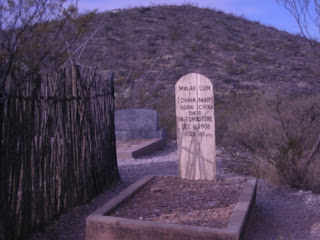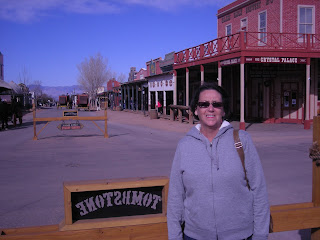Boothill Graveyard
Graves of Billy Clanton, Frank McLaury, and Tom McLaury in Boothill Graveyard, Tombstone, Arizona.
The most notable use of the name Boot Hill is at the Boothill Graveyard (or Cemetery) in Tombstone, Arizona. 31°43′11. Formerly called The Tombstone Cemetery, the plot features the graves of Billy Clanton, Frank McLaury and Tom McLaury; the three men were killed during the famed Gunfight at the O.K. Corral.
Located on the northwest corner of the town, the graveyard is believed to hold over 300 persons, 205 of which are recorded. This was due to some people (especially Chinese and Jewish immigrants) being buried without record. There is a separate Jewish cemetery nearby with some markers restored, and there are also marked graves of Chinese. However, most of the loss was due to neglect of grave markers and theft of these wooden relics as souvenirs. For example, when former Tombstone Mayor John Clum visited Tombstone for the first Helldorado celebration in 1929, he was unable to locate the grave of his wife Mary, who had been buried in Boothill.
The Tombstone "boothill" cemetery was closed in late 1884, as the new "City Cemetery" on Allen Street opened. Thereafter, Boothill was referred to as the "old city cemetery" and neglected. It was used after that only to bury a few later outlaws (some legally hanged and one shot in a robbery), as well as a few colorful Western characters and one man (Emmett Crook Nunnally) who had spent many volunteer hours restoring it.
Currently the Tombstone "Boothill Graveyard" is open to the public without fee, and is a popular stop for tourists visiting Tombstone.





Tombstone is a city in Cochise County, Arizona, United States, founded in 1879 by Ed Schieffelin in what was then Pima County, Arizona Territory. It was one of the last wide-open frontier boomtowns in the American Old West. From about 1877 to 1890, the town's mines produced USD $40 to $85 million in silver bullion, the largest productive silver district in Arizona. Its population grew from 100 to around 14,000 in less than 7 years. In 1881, it became the county seat of the new Cochise County.





Far distant from any other metropolitan city, by mid-1881 Tombstone boasted a bowling alley, four churches, an ice house, a school, two banks, three newspapers, and an ice cream parlor, alongside 110 saloons, 14 gambling halls, and numerous dancing halls and brothels.[citation needed] All of these were situated among and on top of a large number of dirty, hardscrabble mines. The gentlemen and ladies of Tombstone attended operas presented by visiting acting troupes at the Schieffelin Hall opera house, while the miners and Cowboys saw shows at the Bird Cage Theatre, "the wildest, wickedest night spot between Basin Street and the Barbary Coast."



Under the surface were tensions that grew into deadly conflict. Many of the Cowboys were Confederate sympathizers and Democrats. The capitalists and townspeople were largely Republicans from the Northern states. The fast-growing city, only 30 miles (48 km) from the U.S./Mexico border, was a wide-open market for beef stolen from ranchos in Sonora, Mexico by the outlaw Cowboys. These men were a loosely organized band of friends and acquaintances who teamed up for various crimes and came to each others aid.


The Earp brothers—Virgil, Wyatt, Morgan and Warren Earp—arrived in December 1879 and the summer of 1880. All assumed roles as lawmen at one time or another which led to ongoing conflicts with Ike and Billy Clanton, Frank and Tom McLaury, and other Cowboys. After repeated threats against the Earps by the Cowboys over many months, the conflict escalated into a confrontation that turned into a shoot out, the now-famous Gunfight at the O.K. Corral.

In the mid-1880s, the silver mines penetrated the water table and despite significant investments in pumps, mining operations were unable to continue. Its economy today is based on tourism. The city's population dwindled to a low of about 800 in the early 20th century but has stabilized at about 1500 residents. According to 2006 Census Bureau estimates, the population of the city was 1,569.





























